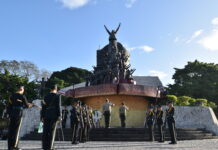ECONOMIC experts urged the government to focus on addressing the health crisis and helping the private sector in 2021 after the economy plummeted by a record 9.5 percent in 2020, the worst since World War II, due to the Covid-19 pandemic.
UST Department of Economics Chairman Carlos Manapat said the country’s gross domestic product (GDP) would see an uptick only in the second or third quarter of 2022, when the economy goes back to pre-pandemic levels.
Manapat said this year’s P4.54-trillion national budget was expected to pave the way for a “V-shaped” recovery, where the historic slump would be followed by a strong bounce-back.
“This is the most ideal… If [the] government keeps on spending this much, it will create a scenario of [reaching pre-pandemic levels with a] 1.2 percent GDP growth in either the 2nd or 3rd quarter of 2022,” he told the Varsitarian in an interview.
The Development Budget Coordination Committee however expects GDP growth to reach 6.5 to 7.5 percent in 2021.
A consensus survey by think tank Japan Center for Economic Research and Nikkei expects the Philippine economy to bounce back to pre-pandemic levels in 2022.
Manapat said this would be possible if the country did not let the unemployment rate soar past nine percent.
“This is assuming na (that) we are in full employment. Ang full employment kasi (what full employment means) is that the unemployment rate should be about 8 to 9 percent, ibig sabihin employed ang tao up to 91 percent (meaning up to 91 percent of people are employed),” Manapat said.
Manapat said the economy’s return to pre-pandemic levels could be achieved faster if other countries resumed the recruitment of overseas Filipino workers (OFWs) who have been stranded in the Philippines due to the pandemic.
This would be an “adrenaline” boost to the country since the Philippine economy is driven by consumption, he said.
UST and Ateneo de Manila University professors last year forecasted a loss of $3 billion to $6 billion in total remittances, with 300,000 to 400,000 OFWs affected by layoffs and pay cuts amid the pandemic.
The Bangko Sentral ng Pilipinas (BSP) reported that remittances dropped by 0.8 percent from $30 billion in 2019 to $29.9 billion in 2020.
In August, the Department of Labor and Employment reported that 600,000 OFWs were displaced.
Asst. Prof Jeremiah Opiniano, executive director of the Institute for Migration and Development Issues, warned against sending OFWs to foreign countries for the sake of economic recovery.
“In general, overseas migration is largely an individual decision —and the government should not make this individual decision a deliberate policy for economic recovery under this pandemic era,” Opiniano told the Varsitarian in an online interview.
“The priority here is the health and well-being of these workers. Lessons from 2020 may provide Philippine authorities ideas on how best to facilitate safe, orderly and healthy overseas migration,” he added.
Opiniano cited data from the Philippine Overseas Employment Administration that as of October 2020, the deployment of migrant workers was halved at about 700,000.
Weak pre-pandemic economy
Sonny Africa, executive director of IBON Foundation, a think tank, said the Philippine economy was already weak prior to the pandemic, in a webinar titled “Ekondisyon: Philippine Economic Recession and Covid-19” conducted by the UST Central Student Council on Jan. 29.
“When the government’s economic managers say the economy is strong, they say we have good credit rating, creditworthiness and our debt rating was low,” Africa said.
He said the Philippine economy was not structurally developing because of the country’s falling production sector, resulting in fewer jobs generated.
“Despite experiencing a rapid growth since the 2000s and despite legitimate claims that growth has been the fastest in decades, it’s very striking that jobs have been falling,” he said.
“Our production sector has been collapsing. Bottomline, services won’t just create as many jobs as actual production,” he said.
IBON Foundation noted that the production sector registered 6.8-percent growth in 2016, which increased to eight percent in 2017. However, this dropped to 5.1 percent in 2018 and 3.2 percent in 2019.
BBB not the same as infra budget
Manapat said the landmark infrastructure project of the Duterte administration, “Build Build Build” (BBB), was not enough to boost the economy in the short term.
“In theory, government spending should be initialized so this spending could create additional jobs, which I think [BBB] did before the Covid-19 pandemic,” he said.
According to the Department of Budget and Management (DBM), the Department of Public Works and Highways (DPWH), which accounts for the largest chunk of infrastructure projects, increased its budget to P695.7 billion this year from P431.2 billion previously.
DBM said in a statement last year that the economic services sector, which covers the administration’s BBB scheme, received the second-highest allocation from the country’s P4.506-trillion national budget for 2021 with P1.3 trillion or 29.4 percent of the budget.
Manapat said the BBB however provided a medium-term economic development strategy.
Luis Abad, board chair of the Institute for Leadership, Empowerment and Democracy, a non-profit think tank, and a professor of economics at the Ateneo School of Government, said the procurement of vaccines was crucial to reviving the economy.
“Covid is the immediate threat that we need to mitigate now. We are already seeing the effect with countries like Vietnam and Taiwan that have been able to mitigate Covid early on are now on track to grow their economy,” Abad told the Varsitarian in an interview.
Abad slammed the infrastructure program of the administration, saying it would not help improve the economy amid the pandemic.
“‘Yong mga pinapatayo hindi naman nag-momove ng goods, people and services, most of these are multi-purpose halls na hindi naman natatapos,” Abad said.
“What we’re arguing here is the kinds of infrastructure projects that have been done and selected by this administration are not geared towards enhancing the economy,” he added.
Sen. Panfilo “Ping” Lacson III flagged 5,913 projects under the DPWH as “skeleton projects, such as the construction of multi-purpose buildings worth P135 billion.
Abad pointed out that the BBB was not the same as the infrastructure projects funded in the 2021 budget.
“Katulad ‘yong pinapakita na Skyway from Quezon City to Buendia, wala namang ginastos do’n ‘yong government, so ‘yong pera na nasa BBB hindi ‘yon ‘yong ginamit para sa project na ‘yon,” he said.
The P44.86-billion Skyway Stage 3 was funded by the San Miguel Corp.’s subsidiary, Citra Central Expressway Corp., which was made possible through a Public-Private Partnership deal under the administration President Benigno Aquino III.
Abad, whose father served as budget secretary under the Aquino government, said budgeting reflects on the government’s priorities and understanding as the administration’s “real policy is where you put your money into.”
“The decisions you make [and] the trade-offs you make show the government’s views on where the government wants the country to go and how the country will get there,” he said.
“Depende sa understanding mo kung ano ang mas mahalaga (It depends on your understanding what is more important): a better skilled workforce or more multi-purpose buildings. And what the government is saying, we need more buildings,” Abad added.
Alvin Ang, economics professor at the Ateneo de Manila University, said the problem with the government was not about spending more, but disbursing the funds since a lot of the government budgets for projects remained underspent.
“Hindi naman ‘yong gastos ang problema. Kung nagagastos ‘yong pera ‘yon ang tanong. May pera hindi naman nagagastos… Madaming budget, hindi naman maubos,” Ang told the Varsitarian through a phone interview.
(It’s not about the money. It’s about spending the money, that’s the question. There are funds allotted but not all are being spent.)
Rep. Stella Quimbo of Marikina said the Bayanihan to Recover As One Act or Republic Act 11494 allotted P165 billion for spending, but only P6 billion have been spent. Its effective date is only until June 30 this year, she said.
Quimbo said Congress expected over P2.4 trillion in economic losses due to the pandemic and proposed the Accelerated Recovery and Investments Stimulus for the Economy (Arise) bill that would allot P1.3 trillion for economic recovery. But the Department of Finance (DOF) deemed it unaffordable.
“Ang naging problema dito sa (What happened with) Arise, as soon as we passed it, our economic managers, primarily DOF, said that ‘napakataas naman niyan (it’s too expensive). Napakalaking pera naman ang hinihingi niyo (The amount of money being asked is too much) and we cannot afford that. We can only afford P140 billion,’” she said during the Jan. 29 webinar.
Lawmakers came up with a small version of the Arise Bill, which became the Bayanihan to Recover as One Act or Bayanihan II, she said.


















